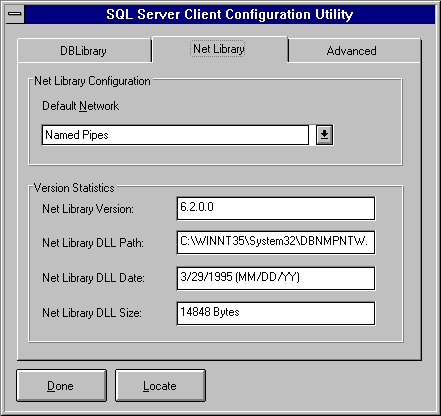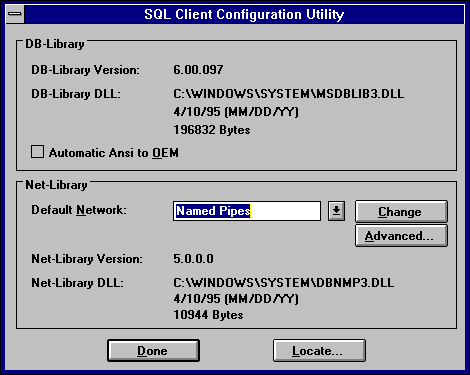 To set the default Net-Library for Windows NT- or Windows 95-based clients
To set the default Net-Library for Windows NT- or Windows 95-based clientsWhen you install SQL Server client utilities on a workstation you can specify the client's default Net-Library, which supports communication between the client and SQL Server. (The setup program's default is to set the Named Pipes Net-Library as the default.) However, if after installation you determine that the client will be regularly connecting to a server that is not configured to support the client's default interprocess communication (IPC) mechanism (for example, NWLink IPX/SPX), after installation you can change the client's default Net-Library.
The following table lists the SQL Server client Net-Libraries for the Windows NT, Windows 95, Windows, and MS-DOS operating systems:
Net-Library |
Windows NT or Windows 95 |
Windows (1) |
MS-DOS |
|
|---|---|---|---|---|
| Named Pipes | DBNMPNTW.DLL | DBNMP3.DLL | DBNMPIPE.EXE | |
| NWLink IPX/SPX | DBMSSPXN.DLL | DBMSSPX3.DLL | DBMSSPX.EXE | |
| Banyan VINES | DBMSVINN.DLL | DBMSVIN3.DLL | DBMSVINE.EXE | |
| TCP/IP Sockets | DBMSSOCN.DLL | DBMSSOC3.DLL | Not available | |
| Multi-Protocol | DBMSRPCN.DLL | DBMSRPC3.DLL (2) | Not available | |
| (1) 16-bit Windows: Microsoft Windows 3.11 and Microsoft Windows for Workgroups.
(2) The Multi-Protocol Net-Library used by Windows-based clients (DBMSRPC3.DLL) also |
||||
Connection limits for each of these Net-Libraries are shown in the following table:
Net-Library |
Windows NT or Windows 95 |
Windows |
MS-DOS |
|---|---|---|---|
| Named Pipes | No limit (1) | 34 (2) | 15 (3) |
| NWLink IPX/SPX | No limit (1) | 25 (2,4) | 15 (5) |
| Banyan VINES | No limit (1) | 15 | 15 |
| TCP/IP Sockets | No limit (1) | 6 | N/A |
| Multi-Protocol | No limit (1) | No limit (6) | N/A |
| (1) Limited only by operating-system memory resources.
(2) Might vary with different versions of DB-Library and the Net-Library (due to (3) Limited by the number of available MS-DOS file handles.
(4) The Windows-based client Net-Libraries use one IPX socket per connection and one
(5) The MS-DOS - based client Net-Libraries use one IPX socket per connection and one to (6) Limit is determined by the underlying protocol that is being used. |
|||
 To set the default Net-Library for Windows NT- or Windows 95-based clients
To set the default Net-Library for Windows NT- or Windows 95-based clientsThe SQL Client Configuration Utility window appears.

 To set the default Net-Library for Windows-based clients
To set the default Net-Library for Windows-based clients

The SQL Client Configuration Utility window appears.

 To set the default Net-Library for MS-DOS - based clients
To set the default Net-Library for MS-DOS - based clientsMS-DOS - based clients use terminate-and-stay-resident (TSR) programs to communicate with the underlying network layer. Only one Net-Library TSR can be loaded at a time. These TSR programs are included with the client software for MS-DOS - based clients: :
Note that MS-DOS-based clients do not support TCP/IP sockets and Multi-Protocol.
During installation, the setup program gives you the option of selecting one of the TSR programs for automatic loading every time the operating system starts, and of adding the \SQL\BIN directory to the system path. If you do not select this setup option, you will need to load the TSR manually. You may also need to make sure the \SQL\BIN directory is in the path.
A TSR can be manually loaded by typing its executable name from a command prompt (for example, type dbnmpipe).
Since only one TSR can loaded at once, a loaded TSR must be unloaded before a different TSR can be loaded. To stop a loaded TSR, run the ENDDBLIB.EXE utility (from a command prompt, type enddblib).
You can also set the default MS-DOS Net-Library by editing the AUTOEXEC.BAT file.